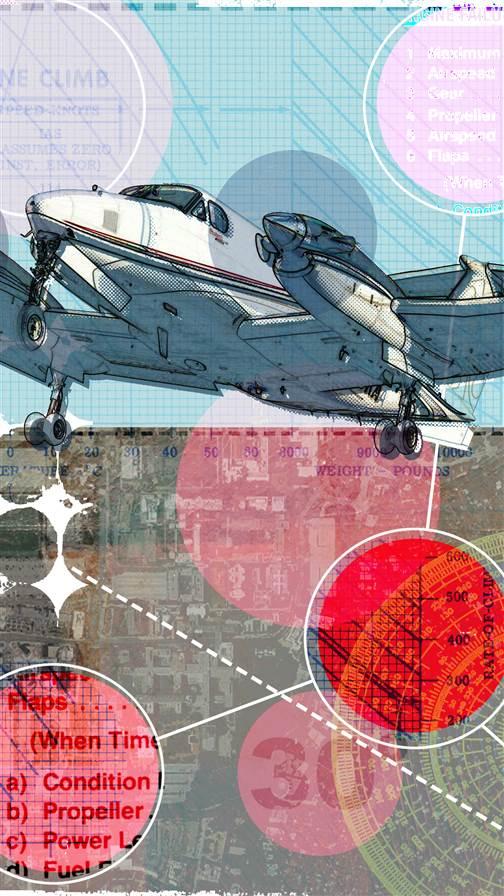Take no shortcuts
Ample single-engine performance won't guarantee a climb
 Wichita, October 2014
Wichita, October 2014
The October 30, 2014, crash of a Beechcraft King Air 200 resonated through the aviation community. The 53-year-old airline transport pilot was alone in the aircraft, which carried no cargo and less than full fuel. One minute and five seconds after receiving his takeoff clearance, he radioed “… declaring an emergency…we just lost the left engine.” Twelve seconds later he transmitted, “We’re going in, we’re dead.” Witnesses and surveillance cameras saw the King Air enter a gradual, descending left turn that steepened in both pitch and bank until it crashed into Flight Safety International’s Cessna training facility. The crash and resulting fire killed three people inside the building (including two in a simulator) as well as the pilot; six others were injured.
Investigators found the King Air’s landing gear still down and locked, corroborating witness accounts. The only surviving flap actuator suggested about a 10-degree deflection, consistent with use of the Approach setting approved for takeoff. Examination of both propellers and analysis of the cockpit voice recorder found evidence that the left engine had not in fact stopped, but was “producing low to moderate power” at impact, likely enough to inhibit operation of its autofeather system. The right engine was judged to have been “producing moderate to high power.”
Fire damage made it impossible to determine the condition of the automatic rudder boost system that should have helped the pilot maintain directional control against asymmetric thrust. However, analysis of surveillance footage concluded that by the moment of impact, the airplane was in a 29-degree left sideslip, an angle that could only have been produced by significant left rudder pressure—input exactly opposite that required to keep the airplane under control. The pilot’s radio transmission showed that he’d correctly identified the faltering engine, so the reason for his inappropriate rudder use remains mysterious.
Elko, Nevada, November 2016
To date, only preliminary information has been released on the November 18, 2016, Piper Cheyenne II air-ambulance accident that killed all four on board. A witness at the airport saw the airplane turn about 30 degrees left from runway heading, then stop climbing before abruptly dropping into a steep left bank and crashing half a mile from the runway threshold. This description of the accident sequence strongly suggests a left engine failure, while the interval between the apparent power loss and subsequent crash was so brief that the pilot would have had little opportunity to accomplish the prescribed emergency procedures.
Tucson, Arizona, January 2017
As of this writing, this accident also remains under investigation, but some facts have been established. The King Air 300 was lightly loaded, with just the pilot and one passenger on board. It crashed into a parking garage seconds after takeoff; witness testimony describes a sudden yaw to the left at about 100 to 150 feet above ground level, followed by a loss of airspeed and a sudden roll to the left as the nose dropped. The airplane eventually hit the ground inverted.
Melbourne, Australia, February 2017
Shortly after lifting off from Essendon Airport on February 21, the pilot of the King Air 300 broadcast seven “Mayday” calls without describing the nature of the emergency. Witnesses familiar with the model described its takeoff roll as longer than usual, and the airplane began yawing left more than 1,000 feet before the departure end of the runway. It maintained a shallow climb for six more seconds, reaching a maximum altitude of 160 feet agl before rolling to the left and descending into a shopping mall at a rate that exceeded 1,200 fpm. Only four passengers and light luggage were on board, as the flight was a day trip for a golf outing.
While the investigation continues, the Australian Transportation Bureau has confirmed that the King Air’s landing gear was found down and locked, and its flaps were extended to the 10-degree takeoff setting. The cores of both engines were found to have been rotating and showed no evidence of internal failure, but other engine components are still under examination. Both propellers showed some evidence of rotation, but their blade angles have yet to be determined. The cockpit voice recorder did not operate during the accident flight for reasons that remain unknown.
Qualifications and caveats
While the sequences of the Elko, Tucson, and Melbourne accidents are each consistent with the sudden loss of power in one engine, lower-probability events such as malfunctions of a primary flight control or autopilot—or pilot incapacitation—have not been ruled out. Although it seems likely that asymmetric thrust will prove to have been causative in at least two and probably all three.
The Wichita and Melbourne accidents in particular make clear that even with more than adequate power for a single-engine climb and automated systems designed to reduce pilot workload during the emergency, prompt and positive action is still required to prevent the resulting yaw from driving the airplane into an unrecoverable attitude. Controlling that yaw and the associated roll—by reducing thrust on the good engine, if necessary—reducing drag, and building airspeed and altitude remain necessary steps for a safe return to base. Don’t try any shortcuts.



